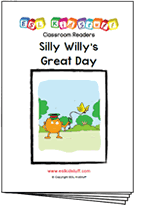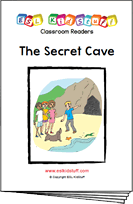Past tense activities – Regular verbs lesson plan
Stand-alone lesson ESL kids lesson plan
Lesson plans for ESL kids teachers

Past tense activities – Regular verbs
In this lesson students practice using the past simple tense with some common regular verbs. Students practice talking about what they did yesterday, conduct a class survey and sing a song.
Members get accompanying flashcards, worksheets, song and classroom reader.
Download materials:
Our lesson plans are FREE!
Sign up for accompanying:
✔ worksheets
✔ homework sheets
✔ craft sheets
✔ flashcards
✔ song downloads & videos
✔ classroom readers & videos
Click to see lesson details, materials and supplies
Time: 40 mins – 1 hour
Objectives: Talking about yesterday using past tense regular verbs.
Structures: “What did you do yesterday?”, “Yesterday, I …(verb+ed”).
Target vocabulary: yesterday, today, tomorrow, fantastic, great, played with my friends, painted a picture, walked in the park, watched TV, jumped in puddles, played a game, kicked a ball, danced.
Lesson materials
Flashcards:
- play with friends, paint a picture, walk in the park, watch TV, jump in puddles, play games, kick a ball, dance
Printables:
- What did you do yesterday? survey worksheet
- Past regular verbs worksheet
- Reader worksheet
- Yesterday was a Great Day! song poster
Songs:
- Yesterday was a great day!
Readers:
- Silly Willy’s great day
Additional materials:
- Past activities (regular verbs) vocab crossword
- Past activities (regular verbs) vocab word search
- Past tense match (regular verbs) worksheet
Supplies:
- [hide_on_uk]colored[/hide_on_uk][hide_on_us]coloured[/hide_on_us] pencils
- a length of rope
- a calendar
- Blu-Tack or tape to stick flashcards to the board
- board with marker / chalk
- device to play the song on
In this lesson students will practice using the past simple tense with some common regular verbs.
Past simple tense verbs come in two forms: regular and irregular, and are used to talk about completed actions in the past. Regular simple past tense verbs are easy to form – you add “ed” to the end of the verb (e.g. I play guitar –> I played guitar).
The past tense simple for regular verbs often has a time reference:
- Yesterday, I played with my friends.
- She watched TV this morning.
- Last Saturday they walked in the park.
- We watched TV last night.
The simple past tense with regular verbs is formed as follows:
- Positive: I jumped in puddles (subject + verb+ed)
- Negative: He didn’t play a game (subject + did + not + infinitve verb)
- Wh question: What did you do yesterday? (Wh question + did + subject + infintive verb)
- Yes/No question: Did he dance with you? (Did + subject + infinitive verb)
Lesson procedure:
Warm up and maintenance:
The beginning of your lesson is extremely important: this is where you set the tone of your lesson and get everyone in the right frame of mind for learning English. It is also an opportunity to check homework and review previous lessons.
Click for warm up suggestions for the start of your lessons
These activities can be done in the following order at the start of your lesson:

1. Greetings and name tags
Greet the students by name as they enter the classroom and gesture for them to sit down. Before class prepare some blank name tags (stickers or pin-on tags). Give these out and have everyone write their names and put their tags on. If you use pin-on tags, you can keep and give out every class.

2. Homework check
Check each student’s homework set in the last lesson. Ask each student some questions about their homework worksheet (e.g. “what [hide_on_uk]color[/hide_on_uk][hide_on_us]colour[/hide_on_us] is it?”), give lots of praise, and then put some kind of mark on the homework sheet (e.g. a sticker, a stamp or draw a smiley face). Finally, tell your students to put their homework back into their bags.
3. Review past lessons
Reviewing past lessons is very important – students need constant practice of new vocab, structures, songs, games and so on. Always review parts of your last lesson as well as some parts from other previous lessons. You can spend 5-10 minutes reviewing – it’s fine to recycle games and activities from your past lessons to review as kids enjoy playing familiar games (although be careful not to play a game to death!). See the section “Other ideas to include in your warm” below for ideas.
You can also include review activities in the main body of your lesson. Kids can have short attention spans so it’s good to be able to pull out lots of activities during different stages of the lesson.
Other ideas to include in your warm up:
Ball pass questions
This is good to review questions from previous lessons. Get everybody standing in a circle.
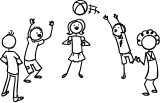
Round 1:
Take a ball and hold it and say, “My name is (you name)”. Then throw the ball to one student and say, “What’s your name?”. Students throw the ball around randomly, saying their names and asking for names.
Round 2:
This time ask a review question, e.g. “How many tables are there?”. Then throw the ball to a student who should answer, “There are (6) tables”. Help if necessary. Then that student throws the ball to another student and asks a “How many …?” question. Continue so everyone has a go. You can have multiple rounds with different topic questions.

Play “Spin the bottle”
Sit students in a circle with a bottle in the middle. Teacher spins the bottle. When it stops spinning the student it is pointing to has to answer a question. If the answer is correct then that student can spin the bottle. This is a good class warm up activity (e.g. How are you? What’s your [hide_on_uk]favorite[/hide_on_uk][hide_on_us]favourite[/hide_on_us] food? How’s the weather today?, etc.
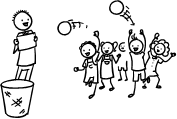
Play “Vocabulary basketball”
This is a fun game which reviews vocabulary from previous lessons. You will need a basket (a trash can) and 2 balls (or 2 pieces of A4 paper scrunched up into balls).
Form 2 teams and line them up so that two players from each team are facing the front with the basket in front of them. Let both players throw their ball – if they get their ball into the basket they can try and win a point by giving the correct answer to a question the teacher asks. This can be an actual question (e.g. What are you wearing?) or a flashcard (What’s this?). Then they go to the back of the line. At the end, the team with the most points is the winner!
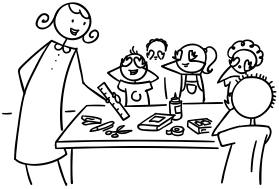
Play “What’s missing?”
This is a fun review memory game – students will have to try to remember review objects from previous lessons (e.g. classroom stationery). Lay the objects out on a table for all to see. Allow the students a minute to memorize the positions of the objects. Remove an object and hold it behind your back. Say, “Open your eyes!” – the first student who can shout out the missing object wins a point for his/her team. Play for all the objects.
Finally, calculate which team has won the most points and give them a round of applause.

Play “Quiz game show”
This is a fun quiz game, like a simple version of a TV game show. Draw some circles on the board and randomly write numbers 1, 2 or 3 in each circle. These will be points.
Put students into teams. Then ask the first team to choose a number – 1 is an easy question (e.g. “Do you like bananas?”) and 3 is a difficult question (e.g. point at a clock and ask, “What time is it?”). 2 will be in between in terms of difficulty. When the question has been answered correctly, erase that number circle. Play until all the number circles are gone – the team with the most points is the winner!
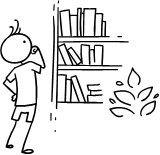
Read a classroom reader again
As you progress through the lessons you will start to build up a catalog of classroom readers (see our Readers download page at https://www.eslkidstuff.com). Kids love going back to old stories and reading through them again. Invite a student to pick a classroom reader and read through it as a class. Make the story as interactive as possible by asking questions (e.g. what [hide_on_uk]colors[/hide_on_uk][hide_on_us]colours[/hide_on_us] there are, the names of different objects, etc.) and getting students to speculate what is going to happen next in the story.

Talk about the weather (do after you have taught the weather lesson plan).
- Prepare a weather board. Before the first class prepare a piece of cardboard and cover it with felt – you are going to pin this to the wall. If you can, try and get blue felt (to represent the sky). Write at the top in large letters, “How’s the weather today?”. Below that write “Today it’s”. Cut out weather pictures (such as our weather flashcards) and stick some velcro on the back. Arrange the weather pictures around the edge of the board and then put the board on the wall of your classroom. You can now use this weather board at the beginning of every lesson.
- Ask about the weather. Ask, “How’s the weather today?” and have students put up their hands. Allow one weather condition per student (e.g. “It’s rainy”) and have each student come up and put a weather picture on the weather board.
- Introduce more weather vocabulary. Depending on weather conditions, you can introduce more weather words (with pictures … you can get students to draw them), such as:
- stormy
- misty
- showery
- freezing
- humid
- frosty
- icy
- drizzly
New learning and practice:
1. Teach “today”, “yesterday” and “tomorrow”
The lesson is based around what your students did yesterday so we will begin with three important time words.
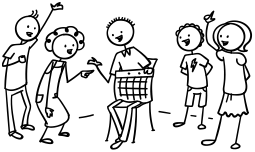
Take a calendar and sit down with your students looking at it … it won’t be long before everyone takes an interest in what you are doing. If you have already taught days of the week and months, point to different days and months and ask what they are. You can also ask students to show you on the calendar when their birthdays are, Christmas and other holidays.
Next, point at today’s date on the calendar and ask, “What day is this?”. As well as the actual day (e.g. Wednesday) teach “today”. Then point to the days before and after today’s date and teach “yesterday” and “tomorrow”.
2. Play “Days rope jump”
You’ll need a length of rope, long enough to lay along the length of your classroom. Lay the rope on the floor and stand facing the rope, so it is horizontal to you. Get all the students to stand on the rope, facing you.
Now demonstrate: jump one step back and shout, “yesterday”. Jump one step forward onto the rope and shout, “today”. Then jump one step forward, in front of the rope and shout, “tomorrow”. Then get everyone jumping, backwards and forwards as everybody shouts together: “yesterday – today – tomorrow – today – yesterday – today – tomorrow – today – etc.”. Keep going, getting faster and faster until it gets too quick to keep up.

Next, you are going to do the same thing, but the teacher is going to say the days randomly. Everyone has to listen carefully and jump into the correct position according to the day the teacher shouts:
- yesterday = behind the rope
- today = on the rope
- tomorrow = in front of the rope
As you do this, try and trick people by saying the same day twice and go at different speeds. As students make mistakes they have to sit out of the game until there is only one left, who is the winner. It’s a really fun game and you can play this a few times.
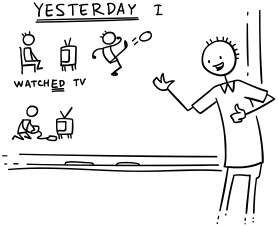
3. Teach vocab for verbs and the regular past tense form
Get everyone to sit down. On the board write, “Yesterday, I …”. Look like you are thinking and say to yourself, “Hmm. What did I do yesterday?”. Then draw a few things which you (may or may not) did yesterday, e.g. watched TV, kicked a ball, played a video game, etc. Make sure they are regular verb activities and try and use some from the song. As you are drawing the pictures get students to shout out what they think each one is and write the simple tense form under each picture (watch TV).
When you have 3 or 4 pictures on the board take a different [hide_on_uk]colored[/hide_on_uk][hide_on_us]coloured[/hide_on_us] marker pen/chalk. Underline “Yesterday” and write “ed” onto the end of the verbs (e.g. Yesterday, I watched TV). Then chorus each of the sentences (e.g. “Yesterday, I watched TV”).
4. Practice saying past tense regular verbs
Before class, print off as many flashcards as you can for regular verbs. Make sure you include the flashcards for the verbs in the song.
Spread the flashcards out, face up, on the floor or a table and get everyone to gather round. Start off by saying, “Yesterday, I …” and select a flashcard and stick it to the board. Then get each student to pick a flashcard of something they did yesterday and also stick to the board – if you have a small class, get students to choose more cards – try and aim for about 10-15 cards and make sure the cards for the song vocab have been selected.
Your board should now be full of flashcards. Your students will probably know some of the verbs from previous lessons and other words they can now learn. Start by touching one card and elicit or teach the verb with the “ed” ending and write the word under the card. Chorus the word 3 times and then move onto the next card. Go through all the cards, at a brisk pace so no one gets bored.

Next, give out the “What did you do yesterday? survey” worksheet. On each line, get everyone to copy 12 verbs in the past form from the board (e.g. “painted a picture”, “watched TV”). This sheet will be used in the next stage of the lesson.
Finally, with all of the cards and words on the board, point at a card randomly and get everyone to shout out the word. Go quickly through all of the words. Then, have everyone close their eyes. Remove a card and erase the word. Then shout, “Open your eyes!” and ask the first student who puts their hand up to say what the missing verb is. If correct, that student can come up to the board and remove the next card (while everyone else closes their eyes), say, “Open your eyes!” and select the first student who puts their hand up. Continue until all of the cards have been removed from the board.
5. Do the “What did you do yesterday? survey” worksheet
Everyone will have filled in the verbs column of their worksheet from the previous activity. Get everyone to stand up and mingle around the classroom so they can fill in their survey. Be sure to model first so that everyone is clear of what to do. The conversations should be as follows:
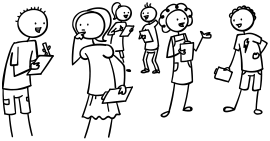
Student A: Ana, what did you do yesterday?
Student B: Yesterday, I watched TV, played a game, kicked a ball, etc. (Student A circles the corresponding cells in the survey worksheet).
When everyone has completed their surveys, pool the answers to find out which of yesterday’s activities were the most common.
6. Sing “Yesterday was a great day!”
The first time you play the song, put up the Yesterday was a great day! song poster on the board. Quickly elicit the vocab. Play the song and sing along doing the gestures, as described below in Gestures below. Play 2 or 3 times.
Lyrics for “Yesterday was a great day!”
Chorus:
Yesterday, yesterday, yesterday
It was a fantastic day!
Yesterday, yesterday
It was a great day!
Verse 1:
I played with my friends (played!)
I painted a picture (painted!)
I walked in the park (walked!)
I watched TV (watched!).
Yesterday, it was a great day!
Chorus:
Yesterday, yesterday, yesterday
It was a fantastic day!
Yesterday, yesterday
It was a great day!
Verse 2:
I jumped in puddles (jumped!)
I played a game (played!)
I kicked a ball (kicked!)
I danced and danced (danced!)
Yesterday, it was a great day!
Gestures for “Yesterday was a great day!”
The gestures are simple and fun to do, matching the verbs in the song.
Chorus:
- “Yesterday, yesterday, yesterday”: stand with feet together and raise your hands up into the air (up and down) on each “Yesterday” (so to form a “Y” shape for “Yesterday”
- “It was a fantastic/great day!”: put your hands over your heart
Verse:
- I played with my friends: put your arms around your closest partners
- I painted a picture: pretend to paint a picture
- I walked in the park: walk on the spot
- I watched TV: fold arms and pretend to watch TV
- I jumped in puddles: jump
- I played a game: pretend to hold and play with a handheld game console like a GameBoy (pressing buttons)
- I kicked a ball: pretend to kick a ball
- I danced and danced: dance!
[hide_on_uk]Short sample (members get full-length song):
[/hide_on_uk]
[hide_on_us]Short sample (members get full-length song):
[/hide_on_us]
7. Read classroom reader “Silly Willy’s great day”
This reader follows on perfectly from the song and helps to reinforce the new vocab with a fun story. Before class, download and print off the reader “Silly Willy’s great day”. As you go through each page, point to the different things Silly Willy did yesterday and elicit the past tense verbs, as well as eliciting what is strange about each activity he does, for example:
Teacher: (reading from page 2) “What did you do, Silly Willy?” Look at the picture. What did Silly Willy do yesterday?
Students: He watched T.V.!
Teacher: Yes, that’s right. (reading) … “Well, first of all, I watched T.V.”. Good! But what is strange about this? (teacher making confused expression while pointing at the picture)
Students: He watched T.V. upside down!
Teacher: Oh yes! Silly, Silly Willy! (Turning to page 2) … Oh, look! What else did Silly Willy do yesterday?
Students: He painted a picture!
Teacher: Yes, he did! But look, what happened?
Students: He painted the picture on his walls!
Teacher: Yes, silly, Silly Willy! Look, he even painted over his cat!
etc.
Continue through the story, eliciting the key vocab. Get the students really involved in the story by asking lots of questions (e.g. about the [hide_on_uk]colors[/hide_on_uk][hide_on_us]colours[/hide_on_us] and objects on each page).
After reading the story, give out a reader worksheet to each student and read through the story one more time (without stopping for questions, etc.) so students can put the pictures in the order of the story and write the missing verbs. Then go through the answers as a class.
Alternatively, watch our video version of the reader (Internet connection required).
8. Play “Past tense slap”
This is a very simple activity to conclude the lesson. Put your students into teams. Hold up a verb flashcard everyone have to slap the table if they know the verb. The student who slaps the table first to give his/her answer with the correct “ed” ending wins a point for their team.

Wrap up:
Assign homework: “Past regular verbs” worksheet
Click for wrap up suggestions for the end of your lessons

1. Assign homework
Each week give out a homework worksheet for your students to take home. Hold up the homework worksheet and model how to do it. Give out the worksheets and say, “Put your homework in your bags”.

2. Do “Quick check”
Time to leave the class. Make sure everything is put away and the students have gathered their belongings. Have them line up at the door and place yourself between the door and the students. For each student check one new word or phrase, for example:
- hold up an object or flashcard (such as an item of clothing) and ask, “What’s this?”
- ask a question from the lesson (e.g. “Where do you live?”, “Do you like bananas?”, “Can you play chess?”, etc.)
When they give you the correct answer say goodbye and let them leave. If their answer is wrong, have them go back to the end of the line – they will have to try again once they reach the front!
Other lesson plans
Actions, verbs & tenses:
- Can – for ability
- Morning routines
- Daily routines & times of the day
- Actions – Present continuous
- Future plans using “going to”
- Past tense activities – Regular verbs
- Past tense activities – Irregular verbs: Part 1
- Past tense activities – Irregular verbs: Part 2
Adjectives:
- Describing people
- Describing things
- Comparing things (Comparative adjectives)
- Comparing things (Superlative adjectives)
Adverbs:
Alphabet:
Animals:
Body:
Classroom:
Clothes:
Colors:
Colours:
Directions:
Family:
Feelings & emotions:
Food:
Health & sickness:
Holidays & festivals:
Jobs:
Likes, dislikes & favorites:
Likes, dislikes & favourites:
- Likes & dislikes
- [hide_on_uk]Favorites[/hide_on_uk][hide_on_us]Favourites[/hide_on_us] and asking why
Nature & Our world:
Numbers:
Places & where we live:
Prepositions of location:
Pronouns:
Shapes:
Shopping:
Sports:
Time, days, months, seasons:
Toys:
Transport & travel:
Weather:


